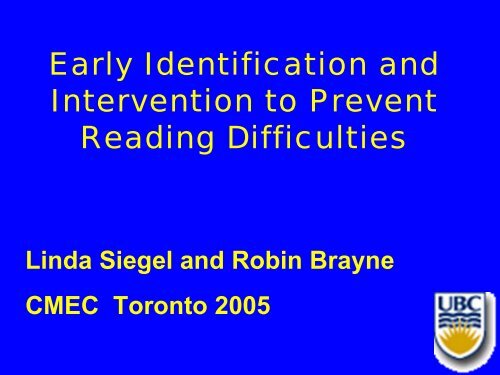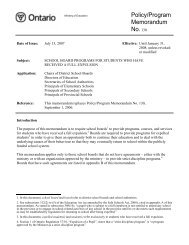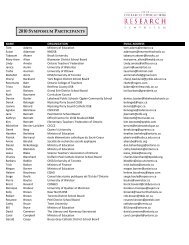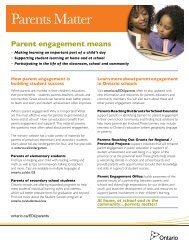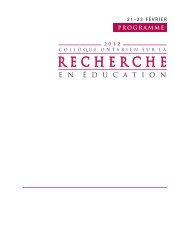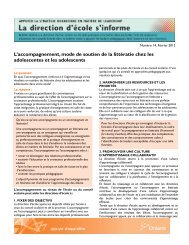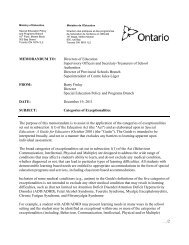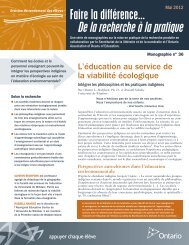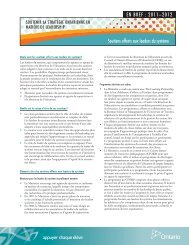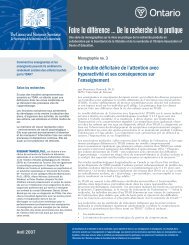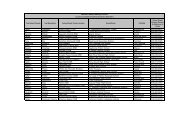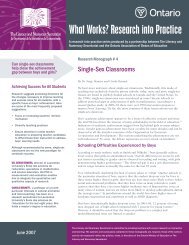Early Identification and Intervention to Prevent Reading Difficulties
Early Identification and Intervention to Prevent Reading Difficulties
Early Identification and Intervention to Prevent Reading Difficulties
You also want an ePaper? Increase the reach of your titles
YUMPU automatically turns print PDFs into web optimized ePapers that Google loves.
<strong>Early</strong> <strong>Identification</strong> <strong>and</strong><br />
<strong>Intervention</strong> <strong>to</strong> <strong>Prevent</strong><br />
<strong>Reading</strong> <strong>Difficulties</strong><br />
Linda Siegel <strong>and</strong> Robin Brayne<br />
CMEC Toron<strong>to</strong> 2005
Partners<br />
• North Vancouver School District<br />
• University of British Columbia<br />
Funders<br />
• Canadian Language <strong>and</strong> Literacy<br />
Research Network (CLLRNET)<br />
• Natural Sciences <strong>and</strong> Engineering<br />
Research Council
Critical Issues<br />
• Recognize <strong>and</strong> treat reading<br />
problems early<br />
• Underst<strong>and</strong> ESL reading<br />
difficulties
Why <strong>Early</strong> <strong>Identification</strong><br />
+ <strong>Intervention</strong><br />
• 82 % of the street youth in Toron<strong>to</strong><br />
had undetected <strong>and</strong> unremediated<br />
learning disabilities<br />
• All the adolescent suicides in a 3<br />
year period in Ontario had<br />
undetected <strong>and</strong> unremediated<br />
learning disabilities
Aims of the Study<br />
• Identify children at risk for<br />
literacy difficulties<br />
• Provide an appropriate<br />
intervention<br />
• Assess the effectiveness of the<br />
intervention
Longitudinal Study<br />
• Screening at age 5 when<br />
children enter school<br />
• Tested every year on<br />
reading, spelling, arithmetic,<br />
language <strong>and</strong> memory skills<br />
• Results at grade 6 – age 12
Longitudinal Sample<br />
• All the children in the North<br />
Vancouver School District<br />
• 30 schools<br />
• Varying SES levels<br />
• 20% English as a Second<br />
Language (ESL)
LANGUAGES IN THE STUDY<br />
• Arabic<br />
German<br />
• Armenian<br />
Greek<br />
• Bulgarian<br />
Hindi<br />
• Can<strong>to</strong>nese<br />
Hungarian<br />
• Croatian<br />
Indonesian<br />
• Czech<br />
Italian<br />
• Dutch<br />
Finnish<br />
• Farsi<br />
• Japanese<br />
• Korean<br />
• Kurdish<br />
• M<strong>and</strong>arin<br />
• Norwegian<br />
• Polish<br />
• Punjabi<br />
• Romanian<br />
Russian<br />
Serbian<br />
Slovak<br />
Spanish<br />
Swedish<br />
Tagalog<br />
Tamil<br />
Turkish
L1 English ESL<br />
normales<br />
Kindergarten<br />
At-risk<br />
Not at-risk<br />
At-risk<br />
Not at-risk
L1 English<br />
Grade 6<br />
<strong>Reading</strong> Disability<br />
Normal<br />
ESL<br />
<strong>Reading</strong> Disability<br />
Normal
Mean percentile<br />
Grade 6<br />
MEASURES OF READING<br />
90<br />
80<br />
70<br />
60<br />
50<br />
40<br />
30<br />
20<br />
10<br />
0<br />
WRAT<br />
reading<br />
WJ word<br />
ntification<br />
WJ word<br />
attack<br />
English normal<br />
reader<br />
ESL normal<br />
reader
Mean percentile<br />
Grade 5<br />
READING COMPREHENSION<br />
60<br />
50<br />
40<br />
30<br />
20<br />
10<br />
0<br />
Stanford reading comprehension<br />
English normal<br />
reader<br />
ESL normal<br />
reader
Why is the North<br />
Vancouver School<br />
District so successful?
North Vancouver<br />
• <strong>Early</strong> screening in kindergarten<br />
• Classroom based intervention with<br />
resource help<br />
• Annual moni<strong>to</strong>ring of reading,<br />
spelling <strong>and</strong> arithmetic
Kindergarten Screening<br />
• Individually administered<br />
• 20-25 minutes<br />
• Classroom teachers can do it<br />
• But must have TOC – substitute teacher<br />
• Provides information about risk status<br />
• Reliable <strong>and</strong> effective
KINDERGARTEN<br />
SCREENING<br />
•LETTER IDENTIFICATION<br />
•MEMORY<br />
•PHONOLOGICAL PROCESSING<br />
•SYNTAX<br />
•SPELLING
Letter <strong>Identification</strong><br />
c r m k b w o<br />
s y t a u d q<br />
x l g e z n j<br />
p h v i f
Phonological Awareness<br />
• Ability <strong>to</strong> break speech down<br />
in<strong>to</strong> smaller units<br />
words<br />
syllables<br />
phonemes
Sentence Repetition<br />
Sentences are spoken orally <strong>to</strong> the child <strong>and</strong><br />
the child is required <strong>to</strong> repeat them exactly.<br />
Examples.<br />
Drink milk.<br />
I like ice cream.<br />
The boy <strong>and</strong> girl are walking <strong>to</strong> school.<br />
The girl who is very tall is playing<br />
basketball.
<strong>Reading</strong> Test
the<br />
<strong>and</strong><br />
sit<br />
when<br />
book
anacampersote<br />
mithridatism<br />
qualtagh<br />
ucalegon<br />
groak
Phonological<br />
Awareness<br />
• Ability <strong>to</strong> break speech down<br />
in<strong>to</strong> smaller units<br />
words<br />
syllables<br />
phonemes
SYLLABLE IDENTIFICATION
RHYME IDENTIFICATION
PHONEME IDENTIFICATION
ORAL CLOZE
• Jane ____her sister went up the<br />
hill.<br />
• Dad ____ Bobby a letter several<br />
weeks ago.<br />
Oral cloze
• child’s name<br />
•mom<br />
•dad<br />
•cat<br />
•I<br />
•no<br />
SIMPLE SPELLING
Firm Foundations<br />
• Activities <strong>and</strong> games designed <strong>to</strong><br />
develop<br />
–Phonological awareness<br />
–Letter sound relationships<br />
–Vocabulary<br />
–Syntactic skills
Firm Foundations<br />
• Rhyme Detection<br />
• Initial Sounds<br />
• Segmentation <strong>and</strong> Blending<br />
• Concepts of Print<br />
• Letter-Sound Correspondences
• Circle Skills -Teaching the whole class<br />
• Centre Skills – Practicing in small groups<br />
• Intensive <strong>Intervention</strong> - Working with<br />
individual students
Terminology<br />
• Phonological Awareness – the ability <strong>to</strong><br />
break down speech in<strong>to</strong> smaller segments<br />
• Phoneme – the smallest unit of sound<br />
• Phonics – a method of teaching reading that<br />
emphasizes the association of sounds with letters
Terminology<br />
• Phonological awareness training –<br />
teaching the sound structure of words<br />
– Audi<strong>to</strong>ry training<br />
• Phonics training – teaching the<br />
connection between sounds <strong>and</strong> letters<br />
– Training with print
Literacy Activities<br />
Listening <strong>to</strong> s<strong>to</strong>ries<br />
Acting out s<strong>to</strong>ries<br />
Singing songs<br />
Letter of the week<br />
Letter cookies
Other Important<br />
Abilities<br />
• Vocabulary – underst<strong>and</strong>ing <strong>and</strong><br />
producing the meanings of words<br />
• Syntax – underst<strong>and</strong>ing the basic<br />
grammar of the language<br />
– Differences between Chinese <strong>and</strong> English<br />
• Verb tenses<br />
• Plurals<br />
•Articles
Mean Percentile<br />
79<br />
78<br />
77<br />
76<br />
75<br />
74<br />
73<br />
72<br />
71<br />
70<br />
69<br />
Grade 6<br />
SPELLING<br />
WRAT3 Spelling<br />
English<br />
normal reader<br />
ESL normal<br />
reader
Percentile<br />
90<br />
80<br />
70<br />
60<br />
50<br />
40<br />
30<br />
20<br />
10<br />
0<br />
Japanese<br />
Grade 6 Spelling<br />
Romance<br />
Spanish<br />
L1 English<br />
Farsi<br />
Tagalog<br />
Chinese<br />
Slavic
Grade 6<br />
SYNTACTIC AWARENESS<br />
Chinese<br />
Japanese<br />
Spanish<br />
Romance<br />
Tagalog<br />
Farsi<br />
L1 English<br />
Slavic
0.6<br />
0.5<br />
0.4<br />
0.3<br />
0.2<br />
0.1<br />
0<br />
SES & <strong>Reading</strong><br />
K-97 K-98 Grade 1 Grade 2 Grade 3
0.7<br />
0.6<br />
0.5<br />
0.4<br />
0.3<br />
0.2<br />
0.1<br />
SES & Spelling<br />
0<br />
K-97 K-98 Grade 1 Grade 2 Grade 3
Conclusions<br />
• It is possible <strong>to</strong> identify children at risk for<br />
reading disabilities in kindergarten.<br />
• It is possible <strong>to</strong> provide a classroom based<br />
intervention <strong>to</strong> bring these children <strong>to</strong> at least<br />
average levels of reading.<br />
• Children learning English as a second<br />
language can perform at L1 levels <strong>and</strong><br />
bilingualism may be an advantage.
Internet Resources<br />
http://www.nvsd44.bc.ca<br />
–Click on Firm Foundations<br />
–Click on <strong>Reading</strong> 44
Contact Information<br />
• linda.siegel@ubc.ca
<strong>Early</strong> <strong>Identification</strong> <strong>and</strong><br />
<strong>Intervention</strong> <strong>to</strong> <strong>Prevent</strong><br />
<strong>Reading</strong> <strong>Difficulties</strong><br />
Linda Siegel <strong>and</strong> Robin Brayne<br />
CMEC Toron<strong>to</strong> 2005
Improving <strong>Reading</strong><br />
Comprehension Skills
<strong>Reading</strong> 44<br />
• Teaches <strong>Reading</strong> Comprehension Skills<br />
• Daily Dozen <strong>Reading</strong> Strategies
1. visual aids<br />
ESL Students<br />
- pictures, graphs, objects<br />
2. reinforce vocabulary through games<br />
e.g. hiding an object, hot-cold<br />
3. dual language picture dictionary<br />
4. dual language books<br />
5. group work provides models
ESL Students<br />
1. Discuss the strategies frequently<br />
2. Daily reading in small groups<br />
- Activates prior knowledge<br />
- Introduces new vocabulary<br />
- Models the reading process<br />
3. Make connections & associations<br />
4. Repetition<br />
- Text with repetitive vocabulary<br />
- Pattern books
ESL Students<br />
5. reading at home in first language of<br />
parent<br />
- read <strong>to</strong> the child<br />
- cloze procedure<br />
6. pre=reading knowledge building<br />
7. select materials <strong>to</strong> build confidence<br />
- 90-95% word recognition
How To Teach Strategies<br />
• identify strategy<br />
• discuss reasons<br />
• demonstrate thinking aloud<br />
• provide opportunities for practice<br />
• reinforce it in small groups<br />
• observe how well the student<br />
uses it
1. ACCESS BACKGROUND<br />
KNOWLEDGE<br />
BRAINSTORMING<br />
a) introduce concept <strong>and</strong> ask the<br />
children <strong>to</strong> generate ideas<br />
b) teacher records all ideas<br />
c) use generated word list on board
BUILDING FROM CUES<br />
• a) teacher shows objects from the s<strong>to</strong>ry <strong>and</strong><br />
students discuss what the s<strong>to</strong>ry may be about<br />
• b) for each object: where / when<br />
character / event<br />
• c) as each object is presented connect it <strong>to</strong><br />
the plot
Vocabulary building<br />
a) Select words such as anthropology <strong>and</strong><br />
psychology<br />
b) Separate the words in<strong>to</strong> parts<br />
c) The students guess what the parts mean<br />
d) The students think of other words with the<br />
same parts e.g., biology
3. FIGURE OUT UNKNOWN<br />
WORDS<br />
W_ w _ ll g _ <strong>to</strong> the f _ _ m th _ s<br />
morn_ _ _.<br />
a) ask students about how they guessed<br />
b) as the teacher is writing, ask students<br />
<strong>to</strong> make predictions
Figure Out Unknown<br />
Words<br />
a) meaning<br />
1) does it make sense?<br />
2) have you heard a word like that before?<br />
b) syntax<br />
1) does it sound right?<br />
2) can you say it that way?<br />
c) visual<br />
1) does it look right?<br />
2) what do you see about that word?<br />
d) self-correction<br />
1) were you right?<br />
2) what else could you try?
4. Self-moni<strong>to</strong>r And Self<br />
Correct<br />
5 Finger Rule<br />
keep track of the words that they do<br />
not know on their fingers<br />
if there are 5 words in the first 100, get<br />
a new book
5 W Questions<br />
To ask yourself while <strong>and</strong> after reading<br />
who?<br />
when?<br />
what?<br />
where?<br />
why?
5. MAKE MENTAL<br />
PICTURES<br />
Guided Imagery<br />
? Does it make sense<br />
Help! Ask for help<br />
→ Read on<br />
← Reread
6. CONNECT WHAT YOU READ<br />
WITH WHAT YOU KNOW<br />
KNOW / WONDER / LEARN<br />
a) Present <strong>to</strong>pic<br />
1) KNOW<br />
What do I know?<br />
2) WONDER<br />
What would I like <strong>to</strong> know?<br />
b) Read selection<br />
3) LEARN<br />
What have I learned?
7) Determine the most important ideas <strong>and</strong><br />
events <strong>and</strong> the relationship between<br />
them.<br />
8) Extract information from text, charts,<br />
graphs, maps <strong>and</strong> illustrations.<br />
9) Identify <strong>and</strong> interpret literary elements in<br />
different genres
10) Summarize What Has Been<br />
Read.<br />
11) Make Inferences <strong>and</strong> Draw<br />
Conclusions.<br />
12) Reflect <strong>and</strong> Respond.


